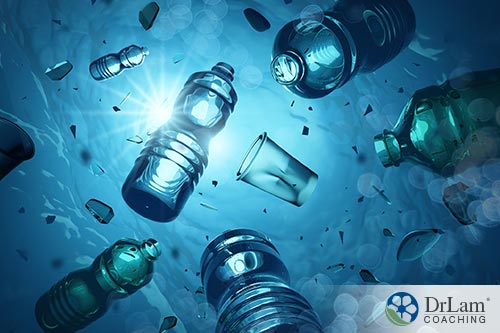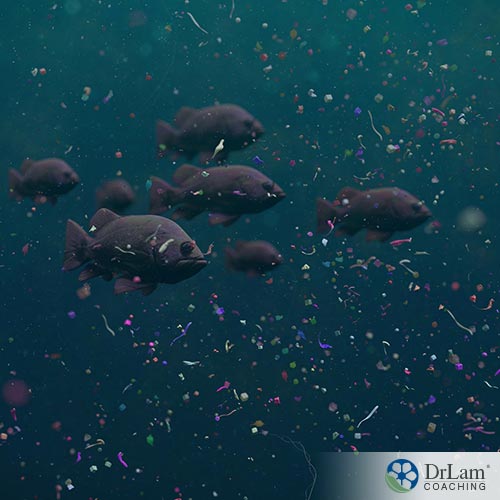 The modern world has lots of benefits and conveniences. It’s now easier than ever to perform household tasks and store food or household chemicals. However, all these conveniences have their downside, and the most obvious is the overuse of plastic. Plastic is a serious environmental threat, but it turns out that it may be just as big a threat to humans. As plastic is broken down, it creates microplastic. These tiny particles are found in every environment and new research shows that the human body is vulnerable to this danger.
The modern world has lots of benefits and conveniences. It’s now easier than ever to perform household tasks and store food or household chemicals. However, all these conveniences have their downside, and the most obvious is the overuse of plastic. Plastic is a serious environmental threat, but it turns out that it may be just as big a threat to humans. As plastic is broken down, it creates microplastic. These tiny particles are found in every environment and new research shows that the human body is vulnerable to this danger.
From consumer to industrial products, plastic is everywhere. And plastic doesn’t break down naturally, which means it has to be disposed of and broken down deliberately and carefully. But it turns out that these processes aren’t careful enough.
Microplastic can found across the planet, from the depths of oceans to Arctic snow. These tiny particles of plastic are less than five millimeters in diameter. Everything you eat, drink, and touch probably has these invisible particles in it. They’re particularly dense in the ocean, where they get into the systems of marine animals which are then ingested by humans. However, this isn’t the only way that you will get an accumulation of microplastics in your system.
These particles are also found in the air that you breathe. People breathe in a lot of microplastic in cities. The level of your exposure may vary depending on where you live and other factors that haven’t been identified yet. So, it’s impossible to avoid these particles.
There are two main types of microplastic:
These account for around 15 to 31 percent of these particles in the oceans. They’re directly released into the environment because of laundering, tire abrasion, or because they’re added to personal care products.
These particles account for around 69 to 81 percent of the microplastics found in the ocean. They’re created as larger plastic objects degrade or are broken down.
For a long time, scientists have struggled with the potential health dangers of microplastic. Unfortunately, these particles are tiny, and the technology to identify whether they could be found in the human body didn’t exist until recently. But now the evidence is in. These tiny particles are in the human body, which means their impact on human health must become a more pressing issue.
Microplastic can be found everywhere, so medical researchers expect to find it in the human body too. Unfortunately, these particles are so small that isolating them is difficult. Plastics in the air often contaminate the results as well. However, technology is moving forward, and researchers can now measure the levels of these particles throughout the body.
Medical researchers have now developed techniques to detect these particles throughout the body. While testing these techniques, they were able to detect microplastics in the lungs, liver, kidney, and spleen tissue. These techniques also allow them to identify different types of plastic in tissue, including polyethylene from plastic bags and polyethylene terephthalate (PET) from plastic drink bottles.
The researchers could also identify bisphenol A (BPA) in the samples. This is a chemical used to make plastics. In animal studies, this substance can hamper development, reproduction, and act as a toxin in the body.
 The real danger of these findings is the fact that no one knows what effects these particles will have on the body. Some animal studies link plastic exposure to health issues like:
The real danger of these findings is the fact that no one knows what effects these particles will have on the body. Some animal studies link plastic exposure to health issues like:
Another issue is the fact that these particles are often covered with other chemicals or microbes that can be dangerous to health. They also contain additives like flame-retardants or stabilizers that are known to be toxic.
All of this makes it obvious how important it is that more research into the impact of plastic on health is carried out. And people need to start thinking about how to reduce their microplastic exposure and the amount of plastic in the environment.
This is important for everyone. But it’s even more important if you’re unwell or are already suffering from a build-up of toxins in your body or other issues relating to detoxification.
The human body has a circuit that’s dedicated to ridding itself of toxins. This is known as the Detoxification Circuit and includes the liver, the immune system, and the extracellular matrix (ECM). This circuit is responsible for deactivating and expelling reactive metabolites that are produced as your body breaks down toxins. The Detoxification Circuit is also part of the NeuroEndoMetabolic (NEM) stress response, which helps resolve everyday stress without it negatively impacting your health.
However, these mechanisms can and do malfunction, usually because of excessive stress and adrenal fatigue. The adrenal glands are responsible for secreting cortisol, the hormone that activates and controls the body’s stress response. When you’re under chronic stress, the constantly high demand for cortisol can bring on adrenal fatigue. And if the situation isn’t alleviated, this can result in Adrenal Fatigue Syndrome (AFS), a too common and misunderstood disorder characterized by full-body symptoms and circuit malfunctions.
The Detoxification Circuit is often one of the first to start to malfunction when you have AFS. And this has widespread implications for your ongoing health, especially in light of the information regarding microplastic contamination.
When the Detoxification Circuit is malfunctioning and unbalanced because of AFS, there is a build-up of contaminants in the body. Typically, the three components in this circuit would clear out these metabolites and toxins. The immune system produces inflammation to expel the invaders, which they are then moved through the ECM to the liver, which deactivates and expels the toxins. But when you have AFS, something different occurs.
AFS causes immune system overactivation and imbalance. As a result, too much inflammation floods the body, creating additional metabolites for the body to cope with. These metabolites start to clog the ECM, slowing down their expulsion and chemical messaging between the cells.
In turn, the liver struggles to cope with the overload of toxins and starts to fail in its duty, leaving reactive metabolites spreading throughout your system. This can be a very dangerous and toxic situation and microplastic will only make it worse.
The malfunctions in this circuit will exacerbate the accumulation of these particles in the body. This may increase the risk of you suffering from some of the health consequences associated with microplastics. And the accumulation of these particles will further tax the Detoxification Circuit, worsening the imbalances and malfunctions. This will naturally increase your stress levels and your AFS, worsening the entire situation and your health overall. This could become very dangerous and difficult to reverse without expert help.
It’s vitally important that you reduce your body’s toxic load when you have AFS. This will reduce the number of reactive metabolites that your body produces, decreasing the demand on the Detoxification Circuit. The Detoxification Circuit will then be able to do its job more effectively, which will reduce stress overall and help alleviate your AFS symptoms.
If you find that you are taking supplements and you end up having an opposite reaction or find that you are overly sensitive to supplements, then your Detoxification Circuit may be overloaded. This is especially important in AFS as multiple circuits are dysregulated, which can confound the overall picture.
You must consult a medical professional who’s aware of AFS during this process. AFS can cause your body to react in paradoxical and sometimes harmful ways to changes. So, any changes that you make to decrease your body’s toxic overload may backfire and cause additional stress, symptoms, and problems. A medical professional who’s aware of adrenal fatigue and the impact it can have on the body will be able to help you avoid these potential consequences.
 Plastic is everywhere and it’s bad for nature, animals, and humans. But, the big pieces of plastic aren’t the main problem. It’s the microplastic that may be the real danger because it’s a hidden yet pervasive threat. If you’re concerned about this issue, here’s what you should know:
Plastic is everywhere and it’s bad for nature, animals, and humans. But, the big pieces of plastic aren’t the main problem. It’s the microplastic that may be the real danger because it’s a hidden yet pervasive threat. If you’re concerned about this issue, here’s what you should know:
If you would like to learn more about toxins in your body that could be affecting your health, the team at Dr. Lam Coaching can help. We offer a free** no-obligation phone consultation at +1 (626) 571-1234 where we privately discuss your issue. You can also send us a question through our Ask The Doctor system by clicking here.
Recent studies have now found that the dangers of microplastic may be more real than previously thought. These tiny particles can be found all over the planet and harm the environment and wildlife. But, they may be present in most of the tissues and organs in your body too.
